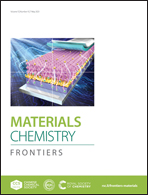Inverted perovskite solar cells based on potassium salt-modified NiOX hole transport layers†
Abstract
Perovskite solar cells (PSCs) have been attracting increasing attention in recent years because of their exceptional high efficiency with incredible developments. However, the poor contact between the hole transport layer (HTL) and perovskite layer still limits the further development of power conversion efficiency (PCE) for inverted solar cells, particularly for inorganic HTL based devices. Herein, potassium salt (KI, KSCN and KNO3) modified nickel oxides are selected as HTLs to improve the photovoltaic performance of an inverted device. We found that all potassium salts play positive roles in optimizing the photovoltaic parameters. Through the modification of potassium salts, higher charge recombination impedance and strong photoluminescence quenching were achieved, which means retarded carrier nonradiative recombination and quick charge transfer at the interface. Besides, KI modified NiOX could improve the perovskite film coverage and reduce trap densities. Thus, the champion device based on a KI modified NiOX film attained a PCE of 20.10% with an enhanced fill factor of 0.812. The findings demonstrate that potassium doping is an effective route to improve the performance of inverted planar PSCs.



 Please wait while we load your content...
Please wait while we load your content...